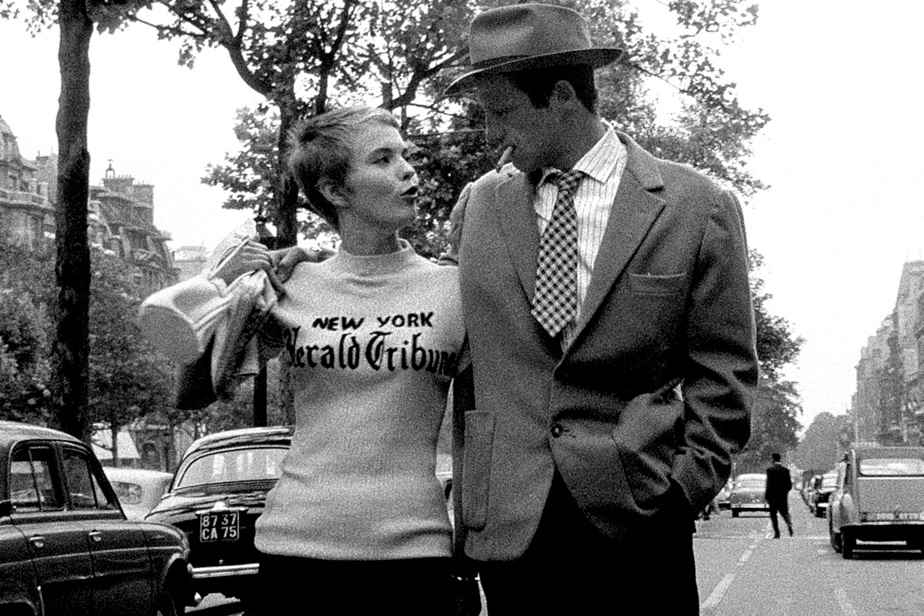(Paris) Among the dozens of films by Jean-Luc Godard, three have entered the history of cinema, all shot in the 1960s: Breathless, Contempt and Pierrot le fou.
Posted at 9:55 a.m.
Breathless (1960)
This is Godard’s first low-budget feature film.
It tells the story of a thug who, after stealing a car and killing a policeman, is tracked down by the police. He tries to convince his American girlfriend to go to Italy.
“It’s a crazy experience, no spots, no makeup, no sound! But it’s so contrary to the ways of Hollywood that I become natural, “summarized Jean Seberg, star, with Jean-Paul Belmondo, of this film, standard of the New Wave.
We find in germ the constituent elements of the following films of “JLG”: cultural references, heady music, bumpy editing, foreign accents, bars, cars, hotels…
The couple’s stroll on the Champs-Élysées, she selling the New York Herald Tribune, chatting to him, cigarette in beak, entered the legend. The film will know a posterity like no other and will receive the Jean-Vigo Prize in 1960. Godard will have the Silver Bear at the Berlin Film Festival the same year.
Contempt (1963)

PHOTO PROVIDED BY RIALTO PICTURES
Brigitte Bardot and Jack Palance in Contempt
The wife (Brigitte Bardot) of a screenwriter (Michel Piccoli) breaks away from her husband and confesses to him the contempt he inspires in her. This is the sixth film of “JLG” and its greatest success.
During filming, “BB” is harassed by the paparazzi. The producers want at all costs to strip her on the screen. Jean-Luc Godard partially gives in. He adds to the film a sequence that has become iconic, where Bardot, lying naked on a bed, questions Piccoli: “And my buttocks, do you like my buttocks? »
Adapted from the novel by Alberto Moravia, the film owes a great deal to a rare lyricism in Godard who was able to count, in addition to an exceptional cast (which includes the filmmaker Fritz Lang), on the score by Georges Delerue, the color photography of Raoul Coutard and the decor of Malaparte’s villa by the sea, in Capri.
It is undoubtedly one of the most intimate films of Godard, then married to Anna Karina. They separated in 1965.
Pierrot le fou (1965)

PHOTO FROM IMDB
Jean-Paul Belmondo and Anna Karina in Pierrot le fou
Godard films Anna Karina for their sixth film together. While the New Wave declines, he masters his art better than ever and indulges in a narrative and visual fireworks display, where the primary colors burst in each image: blue, yellow, red.
Upon its release, the film was banned for those under 18 for “intellectual and moral anarchism”.
“O stupidity of censorship! Serious people have a horror of Godard”, wrote, in this year 1965, Françoise Giroud in The Express. She adds: “The story of the film? I do not know. There must be one, but it doesn’t matter. A man loves a woman, what more do you want? His name is Ferdinand. She calls him Pierrot. Together, they run towards the sun, towards the sea, towards the heat…”. Towards the drama too.
One of the lines, said by Anna Karina, has remained famous: “What can I do? I do not know what to do… “.
Filmmakers like Quentin Tarantino or Leos Carax were influenced by this film, wandering placed under the sign of Rimbaud.
And the other movies?
Jean-Luc Godard shot around 125 films, long and short, fiction and documentary, which had a mixed reception, to say the least, between those who loved it and those who hated it.
We can cite, among his main feature films, The little soldier, A woman is a woman, Live your life, Alphaville, Male Female, The Chinese, Save who can (life), Name Carmen, I salute you marie, Detective, Farewell to languageetc.
But none has acquired the aura of these three great films of the 1960s, one of the richest in French cinema.
